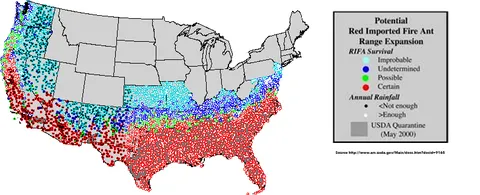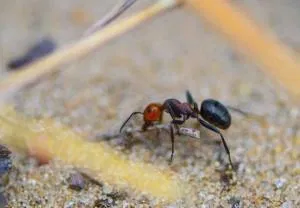Posted by Mike McGinnis on 23rd Jun 2019
Learn More About Fire Ants
Learn more about where fire ants come from, how-to identify fire ants, about how to treat fire ant stings and how to prevent them.

Where Did Fire Ants Come From?
There are several species of fire ant common to the United States, with the Red Import Fire Ant (RIFA) Solenopsis Invicta being considered the worst, and unfortunately most common variety.
They are an invasive species originally thought to have arrived in the 1930s from Paraguay and Brazil through the Bay of Mobile, Alabama and Pensacola Florida. Today they can be found throughout the entire Southern United States.


How-to Identify Fire Ants
The waist of the RIFA consists of two segments. Workers consist of many sizes (polymorphic) between 2.4 to 6 mm (1/8 to 1/4 in). The mandible has four distinct teeth and the antennae are 10-segmented, ending in a two-segmented club. A stinger is present at the tip of the abdomen. Body color is usually red to brown in color with a black abdomen.
The colony constructs large mounds in open area mainly near river beds, streams, watered lawns and flower beds under rocks or logs. They are mainly non-aggressive but will fiercely defend their mounds if
disturbed. They do not hibernate but severe cold spells for several days can destroy 80% of local colonies. The queen can have a life span up to seven years and lay 1500 eggs a day to maintain up to 250,000 workers. They feed on buds and fruits of many crops but especially corn, soybean, okra, and citrus causing severe economic loss to plants and young livestock.

Fire Ant Stings
Their venom (alkaloid), is introduced by a stinger which produces bumps or white pustules and causes a severe stinging sensation. If the area is scratched, bacteria can invade the pustules and cause infection. If left alone, the pustules will flatten by themselves and disappear in a few weeks but can lead to scaring of the area.
In 1% of bites, a severe systemic allergic reaction can occur which requires immediate emergency treatment, as it can be life-threatening.
Bites can also cause systemic allergic reactions (severe chest pain, nausea, severe sweating, loss of breath, slurred speech) must be treated by a medical professional with adrenaline to prevent an anaphylaxis reaction.
Prevention
Learn to recognize the ants’ mounds and anatomy and wear gloves when doing gardening or other work in your yard. The Animal Plant Health Inspection Service, APHIS, of USDA monitors and addresses susceptible areas for fire ant infestation. At a local level infestations can be treated with a variety of approved fire ant baits.
If you do get stung, Stops the Sting!® is proven to stop the pain within seconds and help with the blisters, swelling and irritation while speeding up healing.
Any medical questions should be addressed by trained medical
staff. Please dial 911 if you feel you are having an allergic reaction
or other life-threatening issues.
References:
Medical problems and treatment considerations by Bastiaan Drees, professor and extention entomologist, Texas A and M University, Dec 2002USDA, APHIS Imported Fire Ant Program Manual
University of Florida, Entomology and Nematology Featured Creatures

